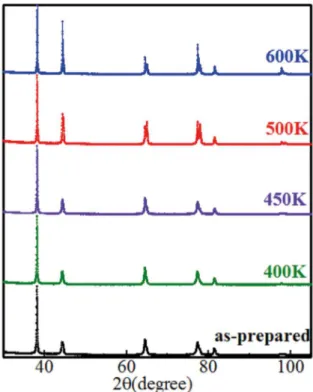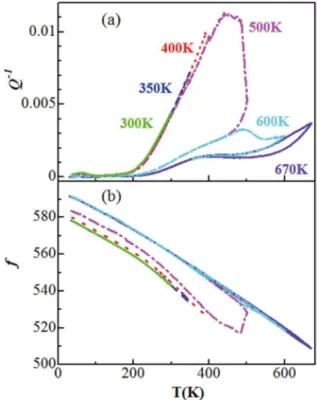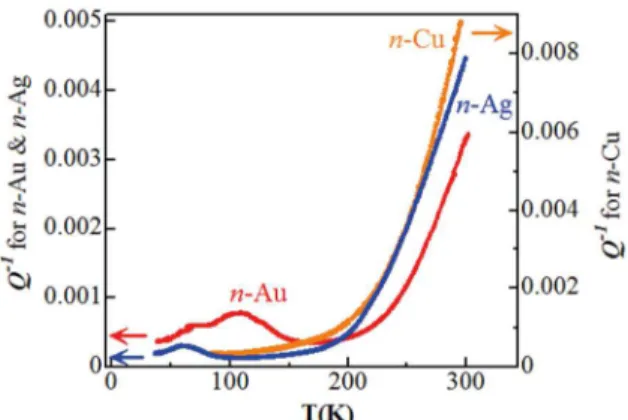Low-Temperature Anelastic Property of Nanocrystalline Ag Fabricated by
Gas Deposition Method
Terigele Xia, Ryoma Suzukia, Hisanori Tanimotoa*
Received: September 29, 2017; Revised: March 07, 2018; Accepted: April 20, 2018
It was reported that the internal friction (Q-1) of nanocrystalline (n-) Au and n-Cu showed a rapid
increase linearly with temperature above ~200 K. Since the rapid increase in Q-1 decreased with the
progress in the grain growth, it was suggested that the anelasticity of grain boundaries in n-Au and
n-Cu was thermally activated above ~200 K. In order to pursue the intrinsic behavior of the grain boundaries in n-metals, the internal friction of n-Ag was measured and the result was compared with those of n-Au and n-Cu. Similar to n-Au and n-Cu, Q-1 of n-Ag was also showed the increase linearly
with temperature above ~200 K. However, the onset temperature for the linear increase in Q-1 of n-Ag
was slight lower than those of n-Au and n-Cu and it can be attributed to the lower activation energy
of the grain boundary self-diffusion in Ag.
Keywords: anelasticity, nanocrystalline Ag, gas deposition method, grain boundary.
*e-mail: tanimoto@ims.tsukuba.ac.jp
1. Introduction
Polycrystalline (p-) materials composed of ultrafine
grains with the mean size less than ~100 nm are called nanocrystalline (n-) materials. It is known that the mechanical property of conventional p-metals is mainly governed by the dislocation activity. Since the dislocation activity is considerably suppressed in n-metals due to the ultrafine grain
size, the mechanical property of n-metals greatly depends on the behavior of the grain boundaries. As well as the much increased volume fraction of the grain boundary region, the state of the grain boundaries also plays an important role on characteristic properties of n-materials. Several investigations were suggested that the grain boundary state of n-materials was different from that of p-materials1,2. When the grain boundary state of n-metals is different from
that of conventional p-metals, the mechanical property
n-metals becomes considerably modified from the p-metal counterparts combined with the much increased factional volume. For the plasticity measurement, it was reported that the creep rate of n-Au showed a sudden increase with several orders in magnitude at the applied stress above 350 MPa at room temperature3. At the same time, the (111) preferred orientation where the most of the crystallites aligned as the <111> directions were normal to the specimen surface was changed to the random texture by the creep deformation, but the mean size was almost unchanged. Further, the independent movement of the crystallites through the grain boundary sliding with keeping the crystallite shape was
observed from the scanning tunneling microscopy under the creep deformation3. These observations suggested that the crystallites are connected with the viscoelastic grain boundaries in n-Au. Since no grain growth was observed after the creep deformation, it was surmised that a quasi-two-phase state composed of the crystallites and the grain boundaries was attained in n-Au4. In contrast, the creep deformation behavior at liquid nitrogen temperature was
much different from that at room temperature and the no
viscoelastic nature of the grain boundaries was suggested3. The internal friction measurement is a powerful and sensitive tool to study behavior of the grain boundaries. For the elasticity measurement, we reported that the internal friction of n-Au showed a rapid increase linearly with temperature above 200 K accompanied with a decrease in dynamic Young's modulus5,6. Since the amount became small with a progress of the grain growth by annealing, the rapid increase of internal friction above 200 K was attributed to a certain anelastic relaxation process in the grain boundaries. These observations indicated that in n-Au, the anelastic nature of grain boundaries becomes thermally activated above ~200 K. The similar increase in the internal friction above ~200 K was also observed for n-Cu7. Combined with the results of the creep deformation, it was suggested that the anelasticity (or viscoelasticity) of the grain boundaries thermally activated above ~200 K in n-metals. In the present study, we carried out the internal friction measurement of n-Ag and the result was compared with those of n-Au and n-Cu in order to pursue the intrinsic behavior of grain boundaries in n-metals.
aInstitutes of Materials Science and Applied Physics, University of Tsukuba 1-1-1 Tennodai, 305-8573,
2. Experimental Methods
High density and high purity n-Ag was prepared by the
gas deposition method. In the gas deposition method, ultrafine
metallic particles formed by the inert-gas condensation process were directly deposited on a glass substrate by using a He
gas jet-flow5. The purity of He used for the gas condensation
and jet-flow was kept better than 99.9999% by a purification
system. In the present gas-deposition method, Ag nanoparticles were deposited on a glass substrate at 265 K by using a cold
finger cooled by liquid nitrogen. By using the XY-stage, n-Ag ribbons of 2 mm wide, 20 mm long and 0.02 mm thick were prepared. The deposition rate, thickness increase per unit area per unit time, was about 74 nm/s. The internal friction and
resonant frequency were measured by using a flexure resonant
vibration (~600 Hz) of a reed specimen, where the vibration was excited electrostatistically. The texture of n-Ag such as the mean grain size and preferred orientation was determined
from the X-ray diffraction measurement with Cu-Kα radiation.
The density of n-Ag was measured by Archimedes method with high purity ethanol. The mean grain size of n-Ag used in the present study was about 30 nm and the density relative to the p-Ag value (10.50 g/cm3) was 97%.
3. Results and Discussion
Figure 1 shows the temperature changes in the resonant frequency and internal friction of n-Ag. For comparison, the data of p-Ag are also shown in Fig. 1. The internal friction of
n-Ag started the gradual increase with increasing temperature at around 110 K and turned to the almost linear increase with the temperature above ~200 K. In contrast, the internal friction of p-Ag started the gradual increase at around 200 K and turned to the rapid increase above 300 K. It was reported that the increase in internal friction associated with grain boundary relaxation in p-Ag was started at around 430 K for the resonant frequency of 1 Hz8.
Figure 2 shows the changes in the X-ray diffraction
pattern of n-Ag by annealing at elevated temperatures for
30 min. The X-ray diffraction measurement was performed by using Cu-Kα radiation for the scattering angle (2θ) from
30° to 105°. The increase in the mean grain size estimated from the peak broadening is depicted in Fig. 3. From Figs. 2 and 3, the grain growth of n-Ag started by annealing above 400 K and the texture change from the strong (111) preferred orientation to the random or (100) preferred orientations by annealing above 450 K.
Figure 1. Temperature changes in internal friction (Q−1, red solid line) and resonant frequency (f, red dashed line) of n-Ag. The data of internal friction (black solid line) and resonant frequency (black dashed line) of p-Ag are also depicted. The frequency normalized
by the value at 37 K is shown in the figure, where f37K of n-Ag is
~300 Hz and that of p-Ag is ~1200 Hz.
Figure 2. X-ray diffraction patterns of n-Ag after annealing at elevated temperatures for 30 min.
The changes in the resonant frequency and internal friction spectra observed for n-Ag by warm-up above room temperature is shown in Fig. 4. No changes in the internal friction spectrum were observed by repetition of cool-down and warm-up below 350 K. As mentioned in Figs. 2 and 3, the apparent grain growth of n-Ag was observed by annealing above 400 K. It is noted that no changes in the internal spectra were observed for n-Au and n-Cu by repetition of cool-down and warm-up below the on-set temperatures of the grain growth. When n-Ag was warmed up to 400 K, a slight decrease in the internal friction and an increase in the resonant frequency were observed. When the specimen was further warmed up to 500 K, the internal friction showed a maximum at around 450 K and turned to decrease rapidly at around 490 K. Corresponding to the decrease in the linear increase of internal friction above ~200 K, the resonant frequency of n-Ag showed increases after the warm-up measurements above 350 K. The sudden and large increase in the resonant frequency in Fig. 4(b) suggests that an abnormal grain growth was occurred at around 490 K. It is noted that dynamic Young's modulus of Ag strongly depends on the crystallographic directions; the largest is 118 GPa along the <111> direction and the lowest is 43.7 GPa along the <100> direction9. The change in the (111) preferred texture to the (100) preferred one shown in Fig. 2 indicates that the mean modulus along the reed length direction much increased due to the texture change by the
abnormal grain growth. By warm-up to 670 K, the internal
friction showed a further small decrease and the resonant frequency a slight increase. These changes in the internal friction and the resonant frequency in Fig. 4 clearly suggest that the linear increase in internal friction above ~200 K is due to a certain anelastic process at the grain boundaries.
A relaxation peak observed for p-Ag at around 100 K is
known as Bordoni peak and the kink-pair formation process
of dislocations was attributed10. A small peak was observed for n-Ag at around 80 K. It was reported that dislocations were hardly detected in n-Ag with grain size less than 100 nm prepared by inert gas condensation and compaction method11,12. On the other hand, the observation of dislocations was reported for n-Ni13. The existence of dislocations in
n-metal is still an open question. The peak at around 80 K of
n-Ag disappeared by warm-up above 400 K where the grain growth was thermally activated (see Fig. 2). We tentatively surmise that the peak at around 80 K of n-Ag is also owing to the grain boundaries3.
The internal friction spectra of n-Ag, n-Cu (the mean grain size ~10 nm)7 and n-Au (~30 nm)14 are compared in
Fig. 5. In the figure, the internal friction due to the grain
boundaries of n-Cu is much larger than those of n-Ag and n-Au because the mean grain size of n-Cu is smaller. Beyond the
differences in the size, it appeared that the onset temperature
of the linear increase in the internal friction for both n-Au and n-Cu was slightly higher than that for n-Ag. The onset
Figure 4. (a) Internal friction (Q-1) and (b) resonant frequency (f)
spectra of n-Ag during warm-up measurements.
temperature of the linear increase in the internal friction estimated by the linear extrapolation was 210 K for n-Ag and 230 K for n-Au and n-Cu, respectively. The internal friction due to the grain boundaries in n-metals can be attributed to a certain anelastic relaxation in the grain boundaries. The probable atomistic process is reversible local site exchange of atoms7. It is expected that the local atom jumps become thermally activated at the onset temperature of the linear increase in the internal friction due to the grain boundaries. It is expected that the activation energy of the grain boundary
diffusion is a rough indication for the onset temperature of
the linear increase in the internal friction. Unfortunately,
almost no data of the grain boundary diffusion energy of
n-metals were reported except for the several reports15,16. In
the first approximation, we refer the activation energy of the grain boundary diffusion in p-metals. The activation energy
reported for the grain boundary self-diffusion in p-Au, p-Cu and p-Ag is 110.6 kJ·mol-1, 107.2 kJ·mol-1 and 84.43 kJ·mol-1, respectively17. The activation energy of grain boundary
diffusion for p-Ag slightly lower than that of p-Au and p-Cu and it is compatible with the lower onset temperature of the linear increase in the internal friction of n-Ag.
It is known that the grain boundary state of n-metals depends on the preparation method or process and the non-equilibrium grain boundaries play an important role on the properties18. Since the nanoparticles are directly deposited
on the substrate by He gas jet-flow in the gas deposition
Figure 5. Comparison of the internal friction spectrum between
n-Ag (blue), n-Au (red), and n-Cu (orange).
be prepared like the severe plastic deformation methods19,20. Recently, we reported characteristic low temperature properties of n-Au prepared by the gas deposition method21. From the thermal analysis of n-Au, an endothermic tendency above 150 K was observed for the repetition of the cool-down and warm-up below 350 K. The deviation to slightly lower values from the linear increase with temperature was also observed for the resistivity of n-Au above ~150 K. As well as the rapid increase in the internal friction, these observations suggested that the reversible state change in the grain boundaries is thermally induced at 150~200 K. These behaviors at low temperatures indicate that a glass-transition-like change of the grain boundaries in n-Au is thermally activated above 150 K and characteristic for the non-equilibrium grain boundaries. The thermal analysis and the resistivity measurement of n-Ag are now in progress to survey the state change in the grain boundaries in n-metals as well as the atomistic process for the internal friction.
4. Summary
The internal friction of n-Au and n-Cu showed a rapid increase linearly with temperature above ~200 K. Since the amount decreased with a progress of the grain growth, the rapid linear increase in internal friction above ~200 K was attributed to a certain anelastic relaxation in the grain boundaries. In the current study, the internal friction of n-Ag was measured and the result was compared with those of
n-Au and n-Cu. For n-Ag, the rapid increase in the internal friction was similarly observed above ~200 K, but the onset temperature of the linear increase with temperature was about 210 K and slightly lower than that of n-Au and
n-Cu. Based on the fact that the activation energy of the
grain boundary self-diffusion reported for p-Ag is lower than that of p-Au and p-Cu, the lower onset temperature of
n-Ag indicates the lower activation energy for the reversible local atomic exchange motions in the grain boundaries of
n-Ag. These observations suggest that the state change of the grain boundaries from elastic to anelastic at 150~200 K is common feature for FCC n-metals.
5. Acknowledgements
The present study was financially supported by the JSPS
KAKENHI Grant 25390027 from the Japan Society for the Promotion of Science (JSPS). The authors thank Prof. Hiroshi Mizubayashi (University of Tsukuba) for valuable discussions.
6. References
1. Suryanarayana C. Structure and properties of nanocrystalline materials. Bulletin of Materials Science. 1994;17(4):307-346.
2. Meyers MA, Mishra A, Benson DJ. Mechanical properties
of nanocrystalline materials. Progress in Materials Science. 2006;51(4):427-556.
3. Tanimoto H. Mechanical Spectroscopy of Nanocrystalline Metals and Nanometer-Thick Films: Characteristic Properties Originated in Nanostructures. Solid State Phenomena. 2012;184:42-51.
4. Yagi N, Rikukawa A, Mizubayashi H, Tanimoto H. Experimental tests of the elementary mechanism responsible for creep deformation in nanocrystalline gold. Physical Review B. 2006;74(14):144105.
5. Tanimoto H, Sakai S, Mizubayashi H. Anelasticity Study on
Motions of Atoms in the Grain Boundary Regions in Nano -crystalline Gold. Materials Transactions. 2003;44(1):53-58.
6. Sakai S, Tanimoto H, Mizubayashi H. Mechanical behavior of high-density nanocrystalline gold prepared by gas deposition method. Acta Materialia. 1999;47(1):211-217.
7. Yagi N, Ueki A, Mizubayashi H, Tanimoto H. Anelasticity in FCC Nanocrystalline Metals. Journal of Metastable Nanocrystalline Materials. 2005;24-25:503-506.
8. Pearson S, Rotherham L. Internal Friction and Grain Boundary Viscosity of Silver and Binary Silver Solid Solutions. JOM. 1956;8(8):894-900.
9. Hellwege KH, ed. Landolt-Börnstein, Numerical Data and Functional Relationships in Science and Technology. Volume
11. Berlin, Heidelberg: Springer-Verlag; 1979.
10. Fantozzi G, Esnouf C, Benoit W, Ritchie IG. Internal friction
and microdeformation due to the intrinsic properties of
dislocations: The Bordoni relaxation. Progress in Materials Science. 1982;27(3-4):311-451.
11. Wang YZ, Cui P, Wu XJ, Huang JB, Cai B. Internal Friction of
Nanocrystalline Silver. Physica Status Solidi (a). 2001;186(1):99-104.
12. Ichikawa S, Miyazawa K, Ichinose H, Ito K. The microstructure of deformed nanocrystalline Ag and Ag/Fe alloy. Nanostructured Materials. 1999;11(8):1301-1311.
13. Wu XL, Ma E. Dislocations in nanocrystalline grains. Applied Physics Letters. 2006;88(23):231911.
14. Sakai S, Tanimoto H, Kita E, Mizubayashi H. Characteristic creep behavior of nanocrystalline metals found for high-density gold. Physical Review B. 2002;66(21):214106.
15. Tanimoto H, Farber P, Würschum R, Valiev RZ, Schaefer HE.
16. Nazarov AA. Grain-boundary diffusion in nanocrystals with a time-dependent diffusion coefficient. Physics of the Solid State. 2003;45(6):1166-1169.
17. Ullmaier H, ed. Landolt-Börnstein, Numerical Data and Functional Relationships in Science and Technology. Volume
25. Berlin, Heidelberg: Springer-Verlag; 1991.
18. Tucker GJ, McDowell DL. Non-equilibrium grain boundary
structure and inelastic deformation using atomistic simulations.
International Journal of Plasticity. 2011;27(6):841-857.
19. Valiev RZ, Alexandrov IV. Nanostructured materials from severe plastic deformation. Nanostructured Materials. 1999;12(1-4):35-40.
20. Sauvage X, Wilde G, Divinski SV, Horita Z, Valiev RZ. Grain boundaries in ultrafine grained materials processed by severe
plastic deformation and related phenomena. Materials Science and Engineering: A. 2012;540:1-12.


